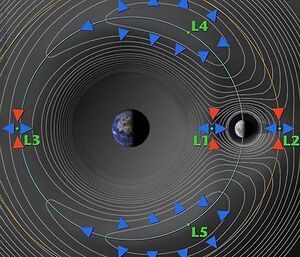Astronomy:Kordylewski cloud
Kordylewski clouds are large concentrations of dust that exist at the L4 and L5 Lagrangian points of the Earth–Moon system.[1][2][3] They were first reported by Poland astronomer Kazimierz Kordylewski in the 1960s, and confirmed to exist in October 2018.[1][2][3]
Discovery and observation
Kordylewski began looking for a photometrically confirmable concentration of dust at the libration (Lagrangian) points in 1951.[4][5]
After a change in method suggested by Josef Witkowski, the clouds were first seen by Kordylewski in 1956.[6] Between 6 March and 6 April 1961, he succeeded in photographing two bright patches near the L5 Lagrange point.[5] During the observation time, the patches hardly appeared to move relative to L5.[5] The observations were taken from the mountain Kasprowy Wierch.[5]
In 1967, J. Wesley Simpson made observations of the clouds using the Kuiper Airborne Observatory.
In October 2018, the existence of the Kordylewski clouds was reported to have been confirmed,[1][2][3] even though, earlier, in 1992, the Japanese Hiten space probe, which passed through the Lagrange points to detect trapped dust particles, did not find an obvious increase in dust levels above the density in surrounding space.[6][7]
Appearance
The Kordylewski clouds are a very faint phenomenon, comparable to the brightness of the gegenschein.[8] They are very difficult to observe from Earth[6] but may be visible to the unaided eye in an exceptionally dark and clear night sky.[8] Most claimed observations have been made from deserts, at sea, or from mountains.[8] The clouds appear somewhat redder than the gegenschein, indicating that they may be made of a different kind of particle.[6]
The Kordylewski clouds are located near the L4 and L5 Lagrange points of the Earth–Moon system.[6] They are about 6 degrees in angular diameter.[6] The clouds can drift up to 6 to 10 degrees from those points.[8] Other observations suggest they move around the Lagrange points in ellipses of about 6 by 2 degrees.[6]
See also
Notes
- ↑ 1.0 1.1 1.2 Royal Astronomical Society (26 October 2018). "Earth's dust cloud satellites confirmed". EurekAlert!. https://www.eurekalert.org/pub_releases/2018-10/ras-edc102618.php. Retrieved 27 October 2018.
- ↑ 2.0 2.1 2.2 Slíz-Balogh, Judith; Barta, András; Horváth, Gábor (11 November 2018). "Celestial mechanics and polarization optics of the Kordylewski dust cloud in the Earth–Moon Lagrange point L5 – I. Three-dimensional celestial mechanical modelling of dust cloud formation". Monthly Notices of the Royal Astronomical Society 480 (4): 5550–5559. doi:10.1093/mnras/sty2049. Bibcode: 2018MNRAS.480.5550S.
- ↑ 3.0 3.1 3.2 Slíz-Balogh, Judith; Barta, András; Horváth, Gábor (1 January 2019). "Celestial mechanics and polarization optics of the Kordylewski dust cloud in the Earth–Moon Lagrange point L5 – Part II. Imaging polarimetric observation: new evidence for the existence of Kordylewski dust cloud". Monthly Notices of the Royal Astronomical Society 482 (1): 762–770. doi:10.1093/mnras/sty2630. Bibcode: 2019MNRAS.482..762S.
- ↑ Trimble, Virginia (2007-09-18). Biographical Encyclopedia of Astronomers: Kordylewski, Kazimierz. ISBN 9780387304007. https://books.google.com/books?id=t-BF1CHkc50C&pg=PA653.
- ↑ 5.0 5.1 5.2 5.3 Kordylewski, Kazimierz (1961). "Photographische Untersuchungen des Librationspunktes L5 im System Erde-Mond" (in German). Acta Astronomica 11: 165–169. Bibcode: 1961AcA....11..165K.
- ↑ 6.0 6.1 6.2 6.3 6.4 6.5 6.6 Laufer, Rene; Wilfried Tost; Oliver Zeile; Ralf Srama; Hans-Peter Roeser (February 2007). "The Kordylewsky Clouds — an Example for a Cruise Phase Observation During the Lunar Mission BW1". 11th ISU Annual International Symposium. Strasbourg. https://elib.dlr.de/49577/1/KordylewskiClouds-Paper.pdf. Retrieved 2018-10-28.
- ↑ "Hiten". NASA. https://nssdc.gsfc.nasa.gov/nmc/spacecraft/display.action?id=1990-007A. Retrieved 2009-03-08.
- ↑ 8.0 8.1 8.2 8.3 Covington, Michael A. (1999). Astrophotography for the Amateur. Cambridge University Press. pp. 32–33. ISBN 978-0-521-62740-5. https://books.google.com/books?id=ZT0ja5EM358C&q=%22kordylewski+cloud%22&pg=PA33.
References
- Kordylewski, Kazimierz (1961). "Photographische Untersuchungen des Librationspunktes L5 im System Erde-Mond". Acta Astronomica 11: 165–169. Bibcode: 1961AcA....11..165K.
- Simpson, J. Wesley (1967). "Dust Cloud Moons of the Earth". Physics Today 20 (2): 39–46. doi:10.1063/1.3034149. Bibcode: 1967PhT....20b..39S.
- Winiarski, Maciej (1989). "Photographic Observations of the Clouds in the Neighbourhood of Libration Point L5 of the Earth–Moon System". Earth, Moon, and Planets 47 (2): 193–215. doi:10.1007/BF00058142. Bibcode: 1989EM&P...47..193W.
- Hypothetical Planets
- A Search for Objects near the Earth–Moon Lagrangian Points, by Francisco Valdes and Robert A. Freitas Jr., did not find any objects at the Earth–Moon or Earth–Sun lagrange points, but this survey was not sensitive to diffuse clouds.
- Roach, J. R. (January 1975). "Counterglow from the earth-moon libration points". Planetary and Space Science 23: 173–81. doi:10.1016/0032-0633(75)90077-x. https://ntrs.nasa.gov/search.jsp?R=19750038268&hterms=counterglow&qs=N%3D0%26Ntk%3DAll%26Ntt%3Dcounterglow%26Ntx%3Dmode%2520matchallpartial. Retrieved 2010-11-28.
- One of Earth’s shimmering dust clouds has been spotted at last


